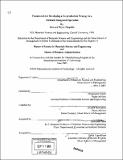Framework for developing a co-production strategy in a vertically integrated operation
Author(s)
Ongchin, Stewart Meyer
DownloadFull printable version (6.183Mb)
Other Contributors
Leaders for Manufacturing Program.
Advisor
Christopher Schuh and Donald Rosenfield.
Terms of use
Metadata
Show full item recordAbstract
The Boeing Company is consolidating its operations for their wing components in order to be more profitable during lower production volumes due to higher utilization rates. In order to support higher production rates moving forward and to mitigate capacity/capability constraints, Boeing will be working more closely with the supply base to implement a new strategic outsourcing relationship -- co-production. Critical elements of a successful supply chain design for Boeing include optimizing the total value stream and validating the capacity and capability of this value stream. The challenge exists to develop this co-production strategy that achieving the strategic objectives. The framework consists of identifying the main objectives for co-production such as risk mitigation and level employment. Next, analysis of the operations based on the main objectives is performed. This involves developing a baseline cost and capacity model of the wing components. Finally, a preliminary co-production scenario is tested and used to validate the effectiveness of co-production in achieving the strategic objectives. The results show that even with the increased asset utilization, the operations are still very costly. When certain product families are compared on a cost per foot basis, an interesting relationship develops where shorter parts are much more costly than longer parts. Another finding is that the required utilization of certain tools is quite high and is beginning to become at risk for meeting demand. A co-production strategy is shown to be favorable in achieving many of the strategic objectives.
Description
Thesis (M.B.A.)--Massachusetts Institute of Technology, Sloan School of Management; and, (S.M.)--Massachusetts Institute of Technology, Dept. of Materials Science and Engineering; in conjunction with the Leaders for Manufacturing Program at MIT, 2005. Includes bibliographical references (p. 56).
Date issued
2005Department
Leaders for Manufacturing Program at MIT; Massachusetts Institute of Technology. Department of Materials Science and Engineering; Sloan School of ManagementPublisher
Massachusetts Institute of Technology
Keywords
Sloan School of Management., Materials Science and Engineering., Leaders for Manufacturing Program.